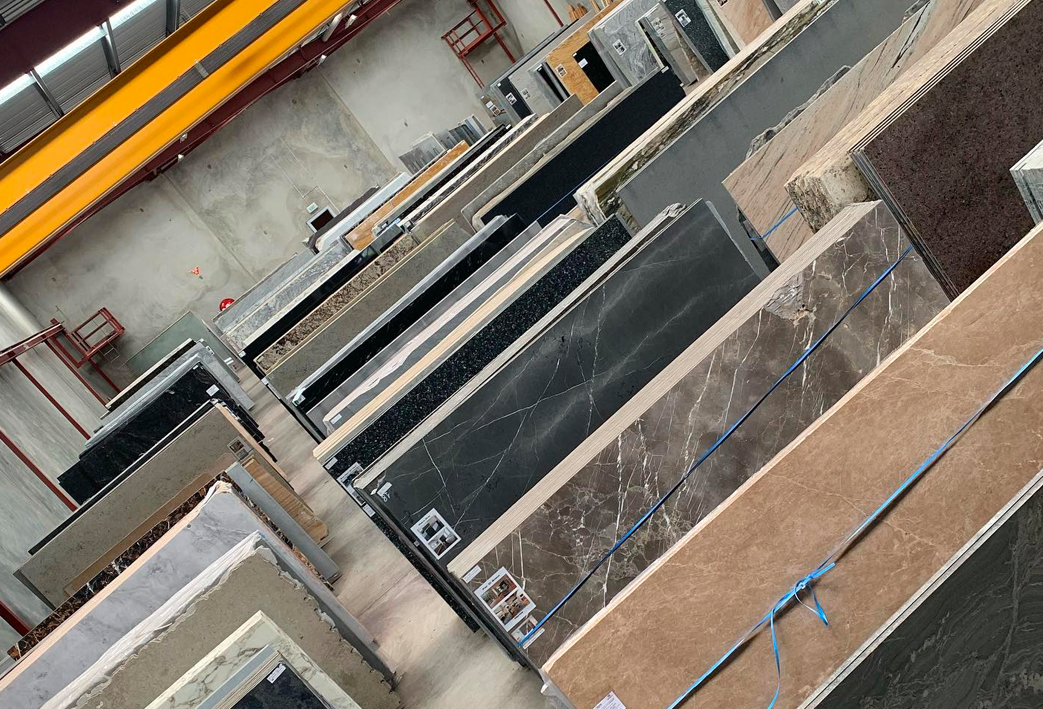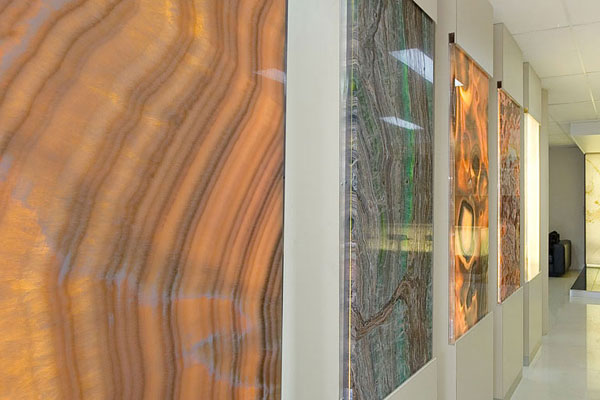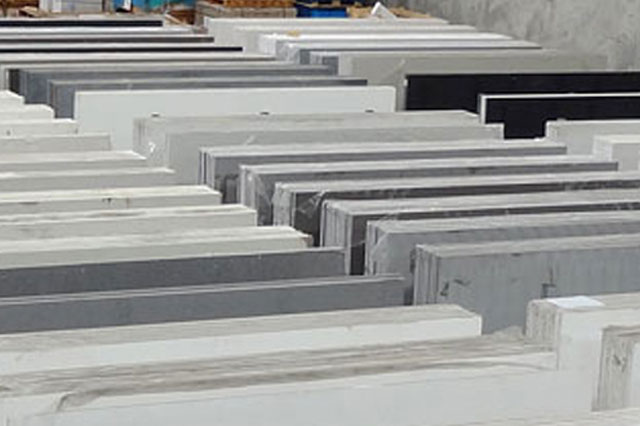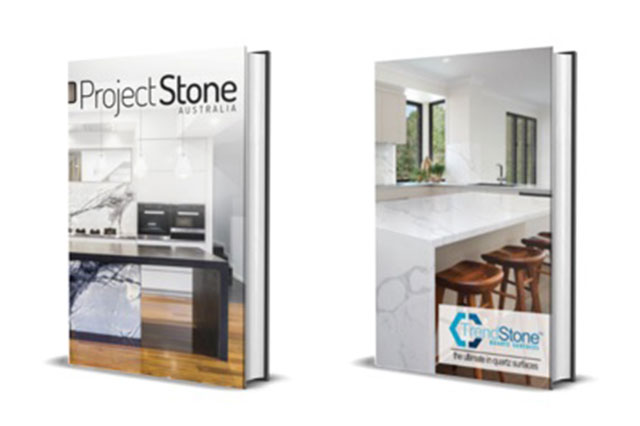FREQUENTLY ASKED QUESTIONS
We import our Natural Stone slabs from many countries across the globe. Many of the granites mainly originate from Brazil, India and Italy. Our Marble and Travertine slabs mainly come from Italy and Spain. Some of our exotic stones can be from lands as far as Madagascar, Angola and Turkey.
No, our slabs of stone are an unfinished product and need to be handled with care by professionals. Also there are many variables in a stone project that affect the cost e.g. type of stone, slab sizes, thickness, edge design, sink type, application. For these reasons it is best to obtain a complete quotation, which will include the stone cost, from your preferred stone fabricator.
This is difficult to answer accurately, as there are too many variables, e.g. type of stone, slab sizes, thickness, edge design, sink type, application etc. As a rough guide finished installed stone tops cost on average approx. $600-$1000/m2.
This is only a very general categorization of stone into price levels. “Standard” is the cheapest and “Exotic” the most expensive. But is only a general guide to tell you that one stone is more expensive than the other. For example the average increase from Standard to High range averages about $200+/m2. There are many other factors that can affect the final price such as slab size, processing characteristics and installation requirements. To get a true comparison ask you stone mason to quote on a short list of your preferred stones to get an accurate quotation.
It is much easier to select your favourite stone first and then choose accessories such as cabinetry, flooring and paint colours to compliment that stone.
First thing to do is come to our showroom/warehouse and view the range of stones currently available. From here you will start with a short list of stones that you like and obtain some quotations in these stones from a stone fabricator. Once you have this information you may come back to make your final selection, grab a sample and then proceed to make selections of your other accessories. Some customers may even come back for an additional visit with their selected tile/cabinetry/ paint colours for one final check.
It is important to inspect the stone closely, not only visually but also by touching the stone. Every stone is different in some way and will also have different textures and levels of polish.
Yes, especially for natural stone, we would recommend that customers come in and view the current batch of natural stone, as every batch varies to some degree. We recommend that you visit 4-6 weeks before your kitchen is scheduled to go in. Small samples can be very deceiving and are an indication only. Engineered Stones do not vary as much as natural stone and these can be selected from a sample, unless for your own peace of mind you would like to see a full size slab, which you are welcome to come in and view.
No, this is not necessary and is not feasible from a safety point of view.
When you visit our premises you will see large natural stone slabs that are stacked on A-frames. There are approximately 20-30 slabs stacked per A-frame side. These 20-30 slabs have been cut consecutively from the same block of stone and hence are very similar, if not identical to one another. The front slab will be turned around so that you can view the full slab and understand the colours, patterns and textures of that particular batch of stone. The slabs behind will be similar, if not identical to this front slab. Most kitchens require on average 2–3 slabs. The slabs are dispatched for customers’ jobs in number order, from front to back, to ensure the best possible grain match. Hence the reason we do not shuffle through the pack of slabs and disturb this order.
It is also work place health and safety policy that slabs are not moved whilst customers are in the warehouse.
To ensure that you get the actual batch of stone you have selected at our premises, you will be provided with the stone name and batch identification number. You will need to pass this information on to your stone fabricator to ensure they collect the correct stone and batch selected by you.
Yes, we endeavour to have small samples available of most of our range but we do run out from time to time. Also keep in mind that samples are not always from the current batch in stock and are not always a good indication. Always best to view current stock available in person. We can also email to you photos of current stock, which can be helpful.
This is a difficult question as it depends on what your priorities are – durability, colour or uniqueness.
There are many various types of kitchen bench top materials available, but if you want to have the ultimate combination of quality, durability and uniqueness, you cannot beat granite. Particularly darker tightly grained granites are very durable; such that these granites are even used as exterior cladding on buildings.
Granite being igneous rock made up of quartz and feldspar has high stain and scratch resistance as well as high heat resistance. Granites can also be polished to a very high gloss level. Also acidic products such as lemon juice do not affect granites.
Quartzite has similar properties to granite if not stronger. Quartzites, in particular Brazilian quartzites are very durable if not more durable than granite but are very unique in that they offer colours and patterns similar to marble and sandstone. They are an ideal choice for bench tops especially when trying to create that wow factor.
Marbles are also natural stones with beautiful patterns and colours and can make the perfect feature island bench or feature splash-back. However marble is not as durable as granite. Marbles generally have lower stain and scratch resistance than granite. Marbles also react with acidic products e.g. Lemon juice, which can cause etching on polished marbles.
Quartz/Composite/Engineered stones are also popular for bench tops. It is a durable product and its main advantage is that being a man-made stone it is colour controlled offering very uniform subtle patterns in light/white colours, which are not available in granites. It also has high scratch, stain and acid resistance, but being resin based is not as heat resistant as granite. This product is not suitable for outdoor use as they are UV sensitive.
Travertine is quarried from ancient hot mineral springs in exotic lands, Travertine is a banded, more compact form of Limestone, characterized by the many holes and chambers evident through the stone. Travertine varies in colour from dusty whites to silver-greys, to gold, coral red and toffee, available with the small holes filled or unfilled, this stone can be effectively polished creating a classy and sophisticated appearance. Current trends have moved towards a honed finish opting for a more untouched “old world” like appeal. Travertine is suitable for both internal and external applications.
Yes, 20mm thick slabs are often used for this purpose to create a very seamless, luxurious look.
Yes, darker coloured granites are the best choice for these areas. We do not recommend the use of engineered stone (Quartz/man-made stone) for BBQ top areas.
Granite and Engineered/Quartz stone are highly scratch resistant but not scratch proof. We recommend that you do not cut on your stone tops. You will also blunt your knives. Always use a chopping board.
Marbles / Travertine’s etc. are softer stones again and will scratch more easily, so never cut on these surfaces.
Never place hot pots or electric skillets on engineered stone. Whilst heat resistant to a point it can burn if very hot items are placed on the surface for an extended period of time. Especially near the edges of your tops, near cut-outs or joins as these points have a higher risk of cracking due to thermal shock. To minimise the risk of cracking due to thermal shock (rapid change in temperature from cold to hot), always use trivets or heat pads to protect your stone surface.
Granite is very heat resistant as it is igneous rock formed under very extreme heat and pressure millions of years ago. Whilst you can place hot items onto a granite surface without burning the stone, there is a risk of thermal shock, prevention is the best cure, so we recommend that you use trivets/heat pads to protect your stone surface.
Marble: Yes you need to have your marble sealed with a good quality penetrating sealer as it is a more porous stone. Unsealed marble will stain more easily. Basically, sealing buys you insurance time to clean spills up before it stains the stone. Penetrating sealers do not alter the appearance or gloss level of the stone.
A penetrating sealer will get into the micro pores of the stone to reduce the ability of contaminants to adhere to the stone. They are not a coating which sits on top of the stone surface.
Although, penetrating sealers will not protect marble from etching (dull spots) as this process is a reaction between the acidic product and the very top surface of the stone.
Coating type sealers are also available (e.g. Dry Treat’s Vitremela) which will protect the marble from etching as well as staining, but does add significant cost to stone top installations.
Granite / Quartzite: Not all require sealing. Generally darker coloured granites do not require sealing at all. As a general rule we recommend that medium to light coloured granites be sealed, as they are generally less stain resistant than darker coloured granites.
Sealing is often a service that is offered by stone fabricators on/before installation but there are also specialized companies such as “The Marble Man” that offer this service after tops have been installed.
This comment is often made by those that have been misinformed. It is important to understand the characteristics and type of stone you are considering along with its intended application. Modern technology has seen the development of impregnating sealers, which offer greater stain resistance on some types of natural stone. With common sense and with the correct care and maintenance your stone surface will offer you many years of enjoyment.
Granites have been the counter top surface of choice for many years due to the highly polished surface that can be achieved. Most granites in our stock have a polished finish, although with the advances in technology stones can now be provided in a range of finishes, e.g. Honed/satin, brushed/leather, flamed/exfoliated etc.
The polish on natural stone is achieved by grinding the surface of the stone to such a compact smooth level that it reflects light. The level of polish on granite does vary depending on the type of stone selected. On most granites, when viewing at certain angles you may notice pits, or an uneven, inconsistent reflection of light. This is due to the fact that granites are made up of different minerals/crystals, in varying densities, which do not all polish up in the same way.
Yes. Marble is very popular for bathrooms due to the soft and elegant patterns and light colours that marble’s/limestone’s and travertine’s offer. It is important that natural stone is sealed correctly in the wet areas.
Yes you can. Whilst not as practical as granite they are very beautiful and are a popular choice. It is a matter of matching the right stone with your lifestyle and what your priorities are. E.g. A family with young children may not choose marble as a counter top due to durability concerns. On the other hand in a very up-market kitchen that may not be used as regularly, design and colour scheme may be a greater priority and they may use marble as a feature on an island bench.
Alternatively you could incorporate a durable granite or engineered stone on the counter tops and marble as a feature on the splash-back or face panel of an island bench.
This is where the marble surface is not polished to the highest gloss level, but to a more moderate satin/matt finish. The reason for doing this is to make the marble surface more forgiving and easier to live with. For example, if you have a polished marble top and happen to spill some lemon juice there will be a dull spot caused by the acidic substance reacting with the surface of the marble making it slightly rougher. This spot will now reflect light in a different way and when looking at the top at certain angles will appear as a dull spot on the surface, which will be quite noticeable against the unaffected polished areas around it. By having honed finish to begin with you are reducing the visual impact of these etch marks (dull spots). The marble will form a natural patina over time and will age more gracefully.
On the other hand, we often have customers that still desire to have the polished look and are happy to have a stone restorer come out and remove any etch marks by re-polishing and resealing the stone from time to time, but obviously this will incur extra maintenance cost.
If you select a marble that is in stock in polished finish it can be taken back to a honed finish by the stone fabricator if you prefer. For marble and travertine this is a relatively easy process. For Granite, special machinery is required which not all stone fabricators may have.
This is when two opposing faces of stone slabs are polished to create a mirror image effect with the pattern of the stone, like butterfly wings opening up. This is a very effective look for wall panels.
- Standard thicknesses available for stone slabs are 20mm and 30mm.
- Granite Slabs average 2750 to 3350mm in length and 1500mm to 1900mm in height.
- Marble Slabs average 2100 to 3000mm in length and 1000 to 1600mm in height.
- Samsung Radianz™ Quartz slabs are 3100x1520mm.
- TrendStone™ Quartz slabs are 3200x1600mm and/or 3000x1600mm.
This is referring to the edge thickness of your bench top. The is the process where 2 pieces of 20mm stone slabs are joined (laminated) together by stone masons, only along the visible edges of your bench top, so as to give the effect that your bench top is a 40mm solid piece of stone. This has been a popular edge detail for many years.
When looking closely at the edge there will be a very thin join line that will be visible. The degree to which this join line is visible is dependent on many factors, e.g. Stone type, stone colour, stone pattern and shape of edge. The best edge shape to disguise this join line is full bullnose (full round). Join lines generally are more visible when edge shapes are flat / square. We recommend that customers discuss edge detail options directly with their stonemason.
No, Quartz is the trade name given to man-made / Engineered stones, for example TrendStone™, Samsung Radianz™ etc. Quartzite is a natural stone, which has similar if not stronger physical-mechanical properties than granite. Quartzite is suitable for both internal and external application depending on the type of Quartzite. Quartzite and in particular Brazilian Quartzite’s can uniquely offer colours and veining similar to that of marble with the added benefit of durability like a granite.
Natural Stone is just that, natural, a product of Mother Nature. It is quarried from the Earth, and processed to the desired finish using special tools. It is unique and impossible to replicate.
Quartz/Engineered stone are actually man-made. It contains approximately 93% crushed natural stone e.g. Quartz crystals, and combined with resin to bind it all together along with added pigments to make the desired colour. It is then pressed into a mould under very high pressure, cured and then polished making a solid, dense slab of stone that is very uniform in colour and pattern. As well as dark shades, Engineered stones offer a range of plain, finely grained whites and creams that are not available in granites. Granite generally reaches a higher gloss level than engineered stone.
We do not recommend that Engineered Stone (aka Quartz) be used outdoors as it is made with resin binders which are UV sensitive and can fade and warp over time.
The first reason is often colour/design choice and secondly it is generally very competitively priced, as now there are many brands on the market. As it is a man-made stone it is very consistent in colour and is an “easier” product to specify for Architects / Designers in large projects as samples are very indicative of final product supplied.
It is a durable, stain resistant product, which makes it a popular choice for interior counter tops. From a fabricators point of view engineered stone is generally more tolerant to flexing and is easier to work with than natural stone. Engineered stone can also be easier to maintain for the end user as it does not require sealing which is required for some medium to light coloured granites and especially marbles.
There is no one answer to this. Engineered stones have different price ranges depending on colour/pattern type and Natural Stones vary greatly in price. A common perception is that natural stone is more expensive than engineered stone but this is not always true. There are granites that sit in the standard (low mid) price range that are equivalent to standard range engineered stone prices. In fact Granite can sometimes be more economical due to its larger slab sizes. For example 1 large sheet of granite can complete a job that may require 2 slabs of engineered stone. To make a true comparison it is best to take a short list of your preferred colours in Granites and Engineered stones to your stone fabricator for an accurate comparison.
Yes, stonemasons work with both Natural Stone and Engineered Stone however if you require a unique or intricate edge detail or have selected a more fragile or exotic stone we recommended that you use a more experienced fabricator who is more specialized in using these types of stones.
No, price of natural stone is not an indicator of quality or durability. Prices on natural stone are based on many factors but the main factor is supply and demand. For example a stone that is very unique, which has great demand on it from all over the world will obviously attract a higher price. Other factors such as quarry size / output, quarry location and quarrying / processing techniques can also affect the final price. Some of the most expensive Natural Stones in the world are also some of the most fragile and difficult stones to work with but are highly valued because of their unique beauty.
Come and visit our showroom and warehouse at Virginia on Brisbane’s Northside and you will have a vast range of Natural Stone and Engineered Stone products to choose from.
Never use harsh cleaners on stone surface. A diluted mixture of Methylated Spirits and water (70/30) and paper towel is a great and cheap everyday cleaner. We also highly recommend the use of Stone Foam as a suitable weekly/monthly cleaner which is fantastic for all types of stone surfaces as well as areas like stainless steel kitchen sinks and shower glass. This product can be purchased directly from Project Stone Australia.
No, never stand on your stone benchtops especially, near sink/hotplate cut-outs or overhangs.
Working with stone products requires specialist equipment and years of experience so we do not recommend that you fabricate your own stone tops.
Tops with rounded edges such as pencil round are the most forgiving type of edge. Another factor will be the overall design concept that will decide which edge design you will go for.
Please contact the stone fabricator that installed your stone tops or contact a specialist stone repairer such as “The Marble Man”.
Natural Stone is the best product for these areas.
Yes. The options are endless.
Yes, 20mm thick Natural Stone or Engineered Stone slabs make a great looking seamless splashback behind sinks and cooktops.
Engineered Stone and Granite are very durable and will maintain their shine without special treatment or chemicals. The polished finish on Marble / Travertine / Limestone can be dulled/etched by acidic substances such as lemon juice. If you would like an etch mark removed then please contact a specialist stone repairer such as “The Marble Man”.
We recommend “Stone Foam” as a weekly/monthly cleaner which will help maintain the shine on your stone tops. Please contact our office if you would like to purchase this product.











